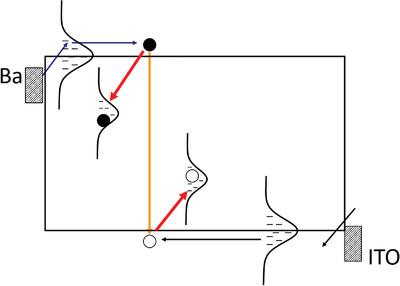当前位置:
X-MOL 学术
›
Adv. Electron. Mater.
›
论文详情
Our official English website, www.x-mol.net, welcomes your
feedback! (Note: you will need to create a separate account there.)
Exciton Quenching due to Hole Trap Formation in Aged Polymer Light‐Emitting Diodes
Advanced Electronic Materials ( IF 5.3 ) Pub Date : 2020-06-11 , DOI: 10.1002/aelm.201700643 Irina Rörich 1 , Quan Niu 1 , Bas der Zee 1 , Esther del Pino Rosendo 1 , Nicoleta Irina Crăciun 1 , Charusheela Ramanan 1 , Paul W. M. Blom 1
Advanced Electronic Materials ( IF 5.3 ) Pub Date : 2020-06-11 , DOI: 10.1002/aelm.201700643 Irina Rörich 1 , Quan Niu 1 , Bas der Zee 1 , Esther del Pino Rosendo 1 , Nicoleta Irina Crăciun 1 , Charusheela Ramanan 1 , Paul W. M. Blom 1
Affiliation

|
Polymer light‐emitting diodes based on two poly(p‐phenylene vinylene) derivatives are aged at a constant current density, leading to the formation of hole traps. Time‐resolved photoluminescence spectroscopy (TRPL) measurements show that the degraded polymer light‐emitting diodes (PLEDs) also demonstrate a decrease in exciton lifetime. The amount of nonradiative exciton quenching sites in the aged devices is quantified by Monte Carlo simulations. It is found that the number of hole traps obtained from electrical charge transport measurements matches the number of newly formed nonradiative quenching sites determined from the TRPL experiments. The results reveal the origin for the apparent different behavior of the electroluminescence and photoluminescence upon PLED degradation. The decrease of the electroluminescence is governed by recombination of free electrons with trapped holes, whereas the photoluminescence is reduced by nonradiative quenching processes between excitons and hole traps.
中文翻译:

老化的聚合物发光二极管中由于空穴陷阱而引起的激子猝灭
基于两个poly(p的聚合物发光二极管-亚苯基亚乙烯基)衍生物在恒定电流密度下老化,从而导致空穴陷阱的形成。时间分辨光致发光光谱(TRPL)测量表明,降解的聚合物发光二极管(PLED)也显示出激子寿命的减少。通过蒙特卡洛模拟量化了老化设备中非辐射激子猝灭位点的数量。发现通过电荷传输测量获得的空穴陷阱的数量与根据TRPL实验确定的新形成的非辐射淬灭位点的数量相匹配。结果揭示了PLED降解时电致发光和光致发光的明显不同行为的起源。电致发光的减少取决于自由电子与捕获空穴的复合,
更新日期:2020-07-13
中文翻译:

老化的聚合物发光二极管中由于空穴陷阱而引起的激子猝灭
基于两个poly(p的聚合物发光二极管-亚苯基亚乙烯基)衍生物在恒定电流密度下老化,从而导致空穴陷阱的形成。时间分辨光致发光光谱(TRPL)测量表明,降解的聚合物发光二极管(PLED)也显示出激子寿命的减少。通过蒙特卡洛模拟量化了老化设备中非辐射激子猝灭位点的数量。发现通过电荷传输测量获得的空穴陷阱的数量与根据TRPL实验确定的新形成的非辐射淬灭位点的数量相匹配。结果揭示了PLED降解时电致发光和光致发光的明显不同行为的起源。电致发光的减少取决于自由电子与捕获空穴的复合,











































 京公网安备 11010802027423号
京公网安备 11010802027423号